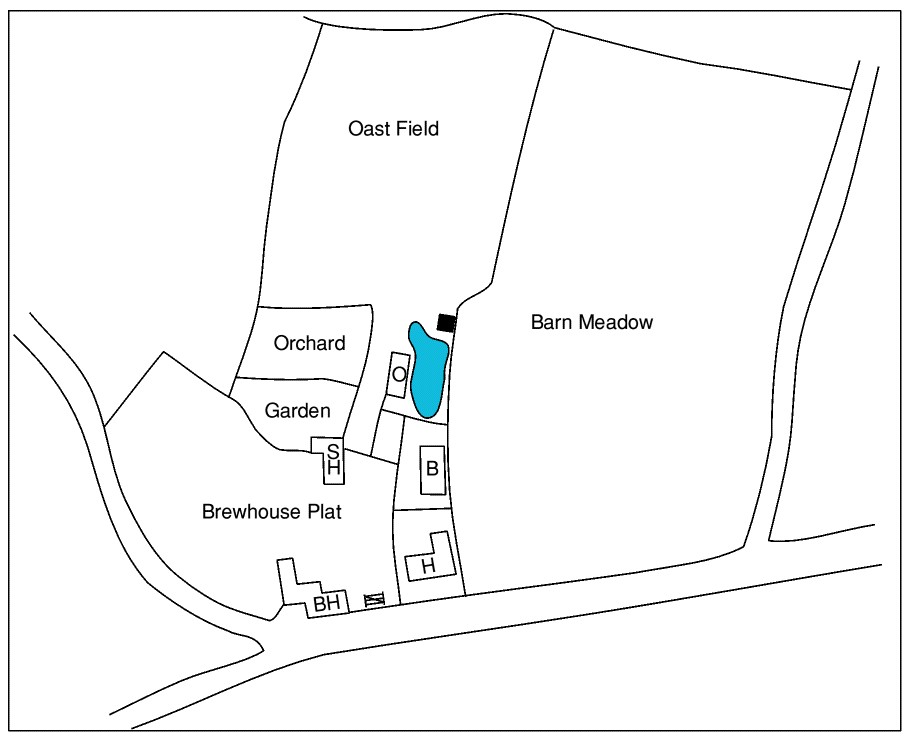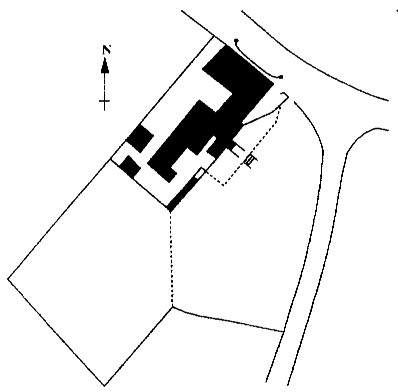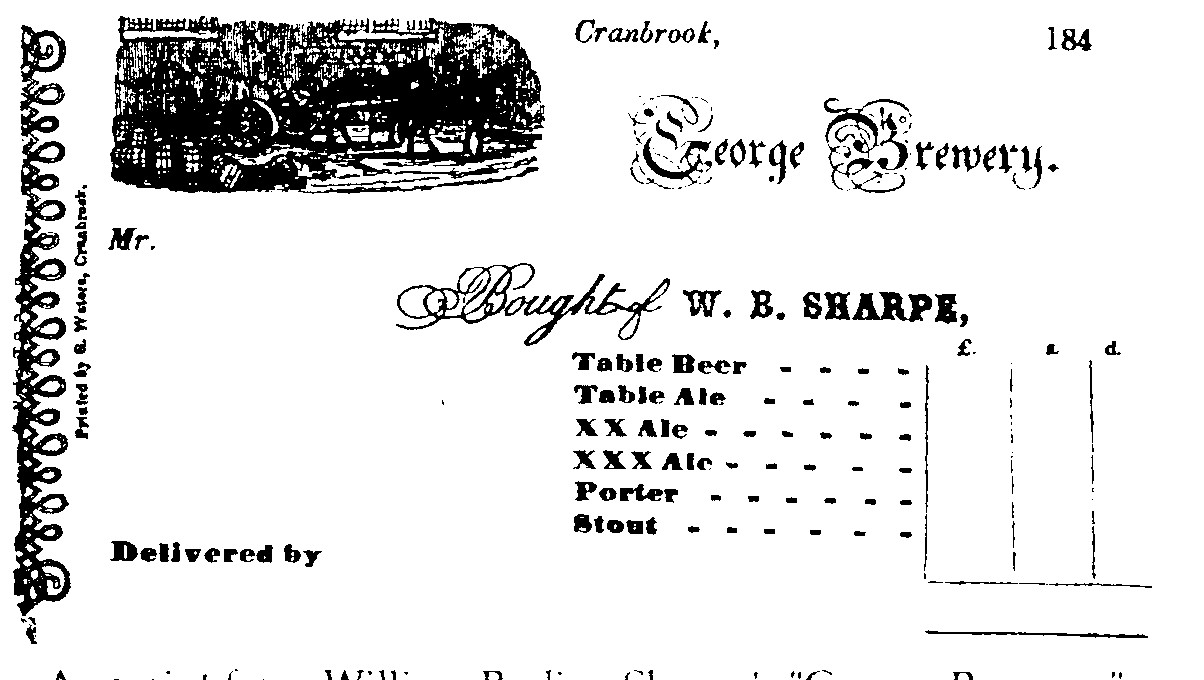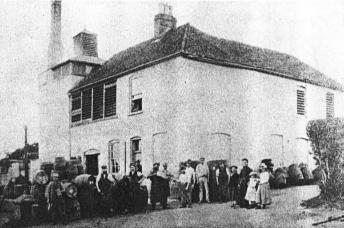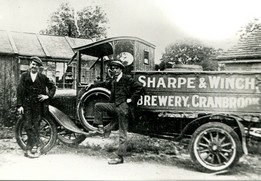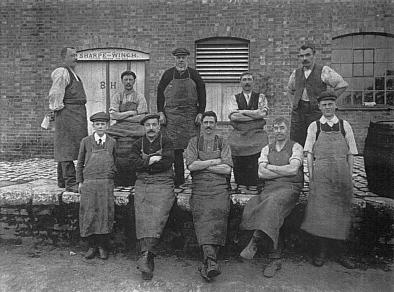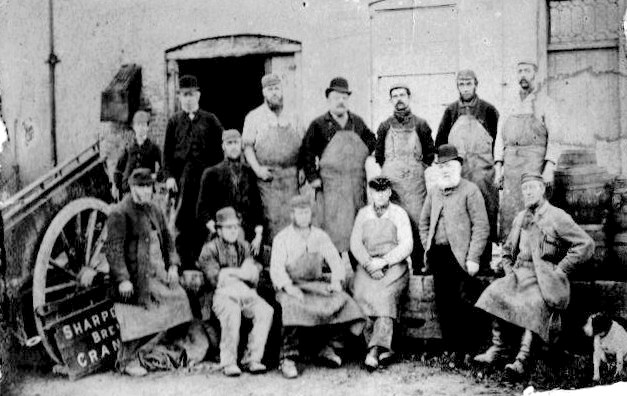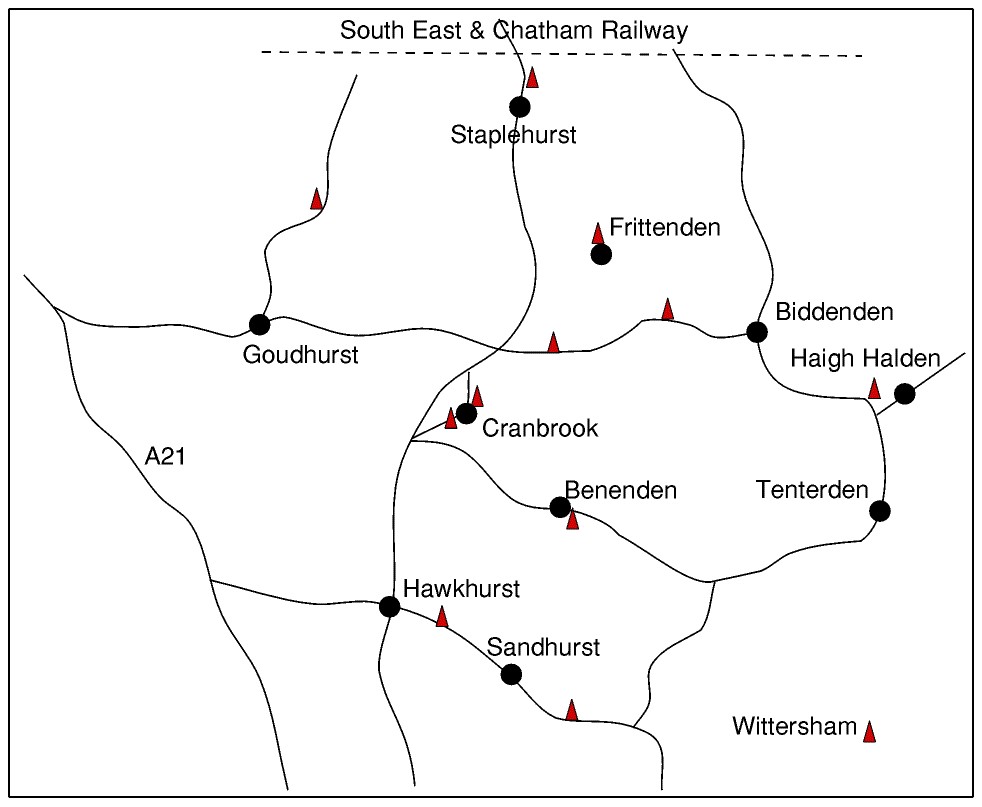Baker's Cross Brewery, Cranbrook |
|
The History of Baker's Cross, Cranbrook, part 2 - Tony Singleton
The article, From Dyehouse to Brewhouse, traced the history of Baker's Cross Farm up to about 1800, by which date a brewery had been built on part of its land by Stephen Wilmshurst. He was born in Cranbrook in 1729, married twice, and fathered a total of nineteen children, although only eight survived to maturity. He first appeared as a Cranbrook ratepayer (1) and a licensee (2) in 1755 at the Bull in Stone Street, moving next door to the King's Head in 1760. He purchased the George Inn from Elizabeth Weston in 1767 (3), and he was renting a barn, stable and brewhouse in the High Street from Joseph Willard in 1769 (4), so perhaps the brewhouse at the George was insufficient for his needs. Stephen's brother, Thomas, took over as licensee of the George in 1762 (2) but later bought the Bull in Stone Street (lately the site of Cranbrook Engineering, now a charity shop) in 1771 (5), mortgaging the property to Stephen in 1778. Stephen is recorded as the ratepayer and appears to have built a brewhouse there in 1780. In 1791 Stephen sold the George to his son Thomas (6), while another of his sons, Tilden, was the landlord there. The Wilmshurst family were involved in the licensed trade in a big way! It is not difficult therefore to see why Stephen decided to build a brewery on the Baker's Cross site, soon after he purchased it in 1787, to supply beer to his large family business. He was described in legal documents as a "common brewer" since he was brewing to supply other people, as opposed to brewing for sale on the premises as many larger inns were still doing in the 18th century. When Stephen Wilmshurst died in 1804, his will (7) directed that all his property should be sold by public auction or private contract and the proceeds were to be divided between his eight surviving children and two grandchildren. The auction on 21st June 1805, only five months before the Battle of Trafalgar, was arranged by John Mott, the Stone Street auctioneer, and advertised in the Maidstone Journal (8). In addition to the "Common Brewery", Stephen had owned "Three Public Inns", the George in Cranbrook, the Duke's Head at Hartley, and The Orange Tree in Frittenden parish, on the Maidstone Road north of Cranbrook. This had previously been part of a farm called The Wren's Nest and had been sold off by the Glassenbury estate two years before (8a). At the auction, his property was sold in lots, the three public inns being sold with the brewery and Baker's Cross Farm as one lot to James Dadson.
However, James Dadson was declared bankrupt in 1810 (6) and, as a result of yet another sale by auction in 1810, the Baker's Cross property was divided, the auctioneer, John Mott, purchasing the farm of thirty acres, while Jesse Dobell bought the brewery and the licensed premises. These now included The Bell Inn in Tenterden, which presumably had been purchased by Dadson. Jesse is first rated for the brewhouse in 1812 at £13, and with a new mood of optimism he built himself a house next to the brewery and took up residence there in late 1813 (1). However, this optimism was misplaced as there was an economic slump after the end of the Napoleonic wars and by June 1819, he was also declared bankrupt - his principal debt of over £518 being to a Hawkhurst farmer, John Levett - and his property was assigned to trustees for sale by auction (9). The trustees were all Cranbrook tradesmen, Thomas Ollive, a watchmaker, Thomas Ditch, a carpenter, and Samuel Reader, a bookseller. The property was described as all that one Brewhouse with the storerooms, Millroom, Granary, Counting house, House, Lodge and other buildings thereto belonging with 1.5acres of land adjoining and all that new built messuage or tenement lately erected and built by and at the cost and charges of the said Jesse Dobell on part of the said piece of land on the south side of the said Brewhouse and near adjoining thereto. Jeremiah Pethurst was the auctioneer on this occasion (8b). According to advertisements in the Maidstone Journal, Jesse Dobell's household effects were auctioned on 6th August, followed by his freehold property on 31st August, 1819 (8c). The latter included the leasehold public house, The Vine, in Wadhurst, in addition to others mentioned before. At the end of the advertisement was a warning to the brewery's customers: N.B. All Persons having any Casks, belonging to the Brewery, are requested to send them to the Brew-house immediately, or they will be charged for the same. From deeds and newspaper advertisements, it is clear that Jesse's brother, Samuel, was a business partner and so it is his name which appears in Tyro Carmina's poem about Cranbrook and its many inhabitants (10): And the Brewhouse - Sam Dobell has taken the lead int Sam Dobell was only rated once for the brewhouse in 1820 and he must have quickly realised that the enterprise was not for him since by the following year George Tomkin, the new owner of the George, had taken over (6). In 1823, the Retail Brewers Act allowed the sale of beer off the premises by small breweries and this may have helped the brewery as local farmers and large houses could now purchase barrels directly, rather than from a pub or inn or brew it themselves. It is not clear whether Tomkin owned or leased the brewery but by the end of 1825 James Youell was "in occupation". William Youell of Yalding leased the brewery so it appears that he may have set up his son(?) in business at Baker's Cross. However, he too was doomed to failure and by July 1827 was declared bankrupt (11). His estate included property in Thurne, Norfolk, and Herringfleet, Suffolk, as well as the lease of the brewery with all and every the brewing plant casks tackle implements and utensils horse cattle corn malt and other stock in trade. The house contents were once again brought under the auctioneer's hammer in September, this time by the Cranbrook auctioneer, William Cloutt, and the house and brewery buildings were auctioned at the George in late October that year. No public houses were tied to the brewery on this occasion but the advertisement in the Maidstone Journal stated that the brewery was within a short distance of "upwards of 30 Free Public-Houses" (8d). Whether a sale was achieved immediately is doubtful since Youell's executors were still paying the poor rate six months later and in October 1828 it was described as 'empty' in the rate books. This nadir in the fortunes of the Baker's Cross brewery coincided with a rather dramatic change in the licensing laws. In the late 18th century the widespread availability of many forms of liquor and the growing problem of drunkenness had led to a prolonged period of strict licensing controls. However in the first quarter of the 19th century the Free Trade movement was gaining support in Parliament and after growing criticism of the ways in which the old licensing laws were being implemented, the Beer Acts of 1830 was passed. This allowed any householder, on payment of two guineas for an excise licence, to open a 'beer shop' or 'beer house' for six days a week (not Sundays) to sell beer and cider, but not wine or spirits. No magistrate's licence was needed and even the excise licence became unnecessary a few months later when the excise duty on beer was repealed (13). The enactment of the Beer Act heralded a new era, with 44000 beer shops opening nationwide and a general day of inebriated rejoicing ensued. In spite of a much depressed economy, or possibly because of it, the beer shops thrived and in the Cranbrook neighbourhood must have created a much increased demand. John Newnham, an Uckfield brewer, anticipating these changes, took the opportunity of reviving the defunct brewery and he was recorded as the ratepayer in January 1829. His son, Charles was installed at Baker's Cross a year later although it was John who secured an improved water supply in March 1831 (14). He negotiated a 21 year lease with the neighbouring farmer, Henry Relf, to draw water from a well there for £1 per year and to lay pipes in the rough over across and along the said piece of land. Over the next three to four years, the brewery ratepayers are recorded variously as Newnham & Co and Newnham & Tooth, indicating a business partnership between the Newnham and Tooth families. In fact, in 1830, John Newnham's daughter, Elizabeth, married John Tooth, son of William, the Cranbrook hatmaker. Charles Newnham. last appears as a ratepayer in June 1835 although he must have left for Australia some months before to join his bother-in-law, John Tooth, to establish the Kent Brewery in Sydney (15). By October 1835. all Newnham involvement in the brewery seems to have ended and Robert Tooth is recorded as the owner of the brewery with Francis Curtis occupying the brewer's house next door. The only surviving part of the brewery buildings, now used by Tudor Oak as workshops, has a brick set in the west facing wall with the inscription RT 1836, clearly indicating its date of construction and its builder as Robert Tooth, another of the hatmaker's sons. A substantial part near the road has been demolished but would have contained the fermentation vats where the beer was produced. Below are extensive cellars and the remains of rails for wheeled trucks which conveyed barrels to the north end of the (now demolished) building where the loading bay was positioned abutting the road. The fact that these cellars extend beyond the surviving buildings may have given rise to the highly unlikely tales of tunnels leading from here to Sissinghurst. By 1841 the brewery was well established and Robert Tooth, a cornfactor in the 1830s, was described in the census as a hop merchant. He was living at Baker's Cross, presumably in the house built by Jesse Dobell, and his brewer, Joseph Dinsey, lived nearby on the Hill. He soon set about purchasing land and establishing public houses for the brewery products, building the Royal Oak at Iden Green in Benenden in about 1841, and The Man of Kent in High Halden shortly after (16). Holfield House (previously Bridge Cottages) in Stone Street was also erected on land owned by Robert Tooth and is described as The New Inn in the rate books of the 1840s, although it seems to have reverted to a private residence by the end of the decade. However, Robert Tooth had many other business interests in London and elsewhere and was happy to sell the brewery and its tied houses to Williarn Barling Sharpe, the owner of the George.
William Barling Sharpe was born in 1809, the son of Barling Sharpe, a yeoman farmer of Nash Court in Westwell, and took over as landlord of the George Inn in 1831, aged only 22, purchasing it eight years later (16). Presumably the original brewhouse belonging to the inn had ceased to operate since the inn would have been supplied by the Baker's Cross brewery. However, Sharpe needed to be independent, and so he set up a small brewery of his own near St David's Bridge. A barn and stables in what is now the Tanyard carpark were leased in February 1842 and William Freestone was employed to install the equipment necessary to brew the beer (16). By July the brewery was commissioned and it continued to operate until 1849 although by then Sharpe had purchased the brewery at Baker's Cross. Robert Tooth purchased Swifts and took up residence there in 1845 according to the rate books and Sharpe moved into the house at Baker's Cross in the following year, relinquishing the George to his tenant, Francis Mills. The brewery must have been closed for about two years after this as it is not rated but Sharpe was able to produce all the beer he required from the 'George Brewery'. When the Baker's Cross Brewery re-opened in 1848 it had been downrated from £85 to £55 suggesting some reduction in capacity had taken place. This seems odd since, with the coming of the railways, Cranbrook's fortunes should have been revitalised and with it the brewery's. Certainly by this date, the trade directories mention regular coaches meeting passengers from the trains at Staplehurst and the George had its own fly for the better-off visitors. In 1848 Sharpe raised a mortgage and purchased the Baker's Cross brewery which was then described as brewhouse with the storeroom, mill room, granary, counting house, lodge and other buildings (16).
By comparison with the disastrous events of the first half of the century, the next fifty years were relatively uneventful with a steady growth of the brewery's commercial activity. Unfortunately no business records or ledgers have come to light which might detail the quantities and types of beer brewed at this time but the census returns indicate that the workforce, although never very large, did steadily increase during the last half of the 19th century. According to the 1851 census, Sharpe was living at Baker's Cross and his brewer, Joseph Demsey, was living nearby, (presumably this was a mis-spelling of Robert Tooth's brewer, Joseph Dinsey). In 1861, the spelling of Joseph's surname becomes Dungey and the rather more informative census returns tell us that Sharpe employed ten men at the brewery. The head brewer had an assistant, Henry Stevens, and two more employees lived close by in Tippings Close, Henry Curl and David Dann, who was a drayman. By 1871, the workforce had increased to 14 men and two boys and Sharpe employed his nephew, William Gillett, as his clerk, and James Dann, David's son, as his brewer's assistant. By 1881, Sharpe was farming 440 acres of land in addition to running the brewery where the workforce numbered seventeen men and one boy. Sharpe was described as brewer and maltster suggesting that all the ingredients for the beer were under his control. The output of the brewery now justified two draymen, the ever faithful David Dann as well as Thomas Quaif. Both lived nearby on the Hill, their proximity being a necessity as they would have been required to tend to their horses seven days a week. In 1890 the brewery was bought for £4500 by Cranbrook's auctioneer, William Francis Winch, (17) and presumably took on the name Sharpe & Winch at this time. Winch also came from Westwell and had married Sharpe's daughter, Elizabeth; she died in 1888, after eleven years of marriage, without children. Sharpe continued to lease the house at Baker's Cross (18) and lived there until his death only nine months later in 1891. His burial in Westwell churchyard was reported in the Kent & Sussex Courier on 3rd July where it stated that Mr W May and the remainder of the workmen who were not bearers were in the party of mourners. William May continued to be the head brewer at Baker's Cross for many more years, certainly until the outbreak of the first war. By the end of the century the brewery was a flourishing local concern and an interesting contemporary description of it appeared in The Pictorial Record of 1899 (19):
A bottling plant, however, must have been installed soon after this description was published as Cranbrook Museum has in its collection some bottles, embossed with Sharpe & Winch and older residents recall the existence of a bottling plant there after the 1914-18 war. Other modern developments included the purchase of a Ford T lorry, to assist with deliveries. However, the 'modern tendency' mentioned above continued apace after 1918 and Cranbrook's brewery was bought for £20,000 by Frederick Leney of Wateringbury in July 1928 (20). To be more precise, this was the price paid for thirteen freehold licensed premises and it is clear that Sharpe and Winch between them had steadily built up a chain of tied houses. The brewery buildings were not sold, although hops, malt and sugar as well as some bottles and cooperage materials were included in the sale. Presumably Leney's brewery at Wateringbury had all the capacity needed to keep the Sharpe & Winch houses supplied. However, hardly had the ink dried on the contract but Leney's business was taken over by Whitbread and all Kentish identity soon disappeared. Local residents recall that other public houses were owned or supplied by Sharpe & Winch (not to be confused with the Maidstone brewer, Style & Winch, who owned the White Horse in Cranbrook). These included the Bull and the Bird-in-Hand, both in Stone Street, Cranbrook, but both had ceased to be public houses soon after the first war. The Bull closed its doors in about 1925 and although the buildings on the street were not demolished until well into the thirties, the premises behind were leased to a Mr L Green, a motor engineer, while the Bird-in-Hand reverted to a domestic dwelling.
After William Winch died in 1932, the Bull and Bird-in-Hand were auctioned together with the old brewery buildings and all of Winch's remaining property (21). The brewery failed to reach a satisfactory price, being withdrawn at £1900, and stood empty for several years. Eventually the buildings were sold to a Southborough builder just before the 1939-45 war (22) and the more specialised brewhouse, close to the road, was demolished. The maltings and offices behind were more adaptable and it is these buildings which survive and are now the home of reproduction furniture making. The brewer's house, built by Jesse Dobell in 1813, has undergone some changes but also survives as a reminder of a small country brewery which is no more. Go to article on previous history of the site: From Dyehouse to Brewhouse References: (Centre for Kentish Studies unless otherwise stated) Reproduced from The Cranbrook Journal, No.7 (1994). |
| Back to Home Page | |
